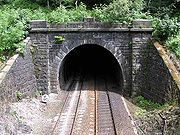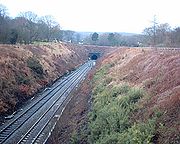
Totley Tunnel
Encyclopedia


Tunnel
A tunnel is an underground passageway, completely enclosed except for openings for egress, commonly at each end.A tunnel may be for foot or vehicular road traffic, for rail traffic, or for a canal. Some tunnels are aqueducts to supply water for consumption or for hydroelectric stations or are sewers...
on the former Midland Railway
Midland Railway
The Midland Railway was a railway company in the United Kingdom from 1844 to 1922, when it became part of the London, Midland and Scottish Railway....
Manchester-Sheffield line between Totley
Totley
Totley is a suburb on the extreme southwest of the City of Sheffield, in South Yorkshire, England. Lying in the historic county boundaries of Derbyshire, Totley was amalgamated into the city of Sheffield in 1935, and is today part of the Dore and Totley electoral ward in the city, though it remains...
on the outskirts of Sheffield
Sheffield
Sheffield is a city and metropolitan borough of South Yorkshire, England. Its name derives from the River Sheaf, which runs through the city. Historically a part of the West Riding of Yorkshire, and with some of its southern suburbs annexed from Derbyshire, the city has grown from its largely...
and Grindleford
Grindleford
Grindleford is a village and parish in the county of Derbyshire, in the East Midlands of England. It lies at an altitude of in the valley of the River Derwent in the Peak District National Park. On the west side of the valley is the high Sir William Hill, and to the south-east lies the gritstone...
in Derbyshire, England
England
England is a country that is part of the United Kingdom. It shares land borders with Scotland to the north and Wales to the west; the Irish Sea is to the north west, the Celtic Sea to the south west, with the North Sea to the east and the English Channel to the south separating it from continental...
. It was completed in 1893 and was the longest mainline railway tunnel within the United Kingdom
United Kingdom
The United Kingdom of Great Britain and Northern IrelandIn the United Kingdom and Dependencies, other languages have been officially recognised as legitimate autochthonous languages under the European Charter for Regional or Minority Languages...
that ran under land for its entire length: the eastern London tunnel of High Speed 1 now holds this title. It is therefore the longest non-electrified tunnel in the UK.
The contractor for 10.5 miles (16.9 km) of the railway, including the tunnel was Thomas Oliver of Horsham
Horsham
Horsham is a market town with a population of 55,657 on the upper reaches of the River Arun in the centre of the Weald, West Sussex, in the historic County of Sussex, England. The town is south south-west of London, north-west of Brighton and north-east of the county town of Chichester...
, West Sussex
West Sussex
West Sussex is a county in the south of England, bordering onto East Sussex , Hampshire and Surrey. The county of Sussex has been divided into East and West since the 12th century, and obtained separate county councils in 1888, but it remained a single ceremonial county until 1974 and the coming...
.
Work began in 1888 with the construction of three brick-built surveying towers along the proposed line of tunnel, followed by a number of vertical shafts to the level of the rails. The Duke of Rutland
Duke of Rutland
Earl of Rutland and Duke of Rutland are titles in the peerage of England, derived from Rutland, a county in the East Midlands of England. The Earl of Rutland was elevated to the status of Duke in 1703 and the titles were merged....
had decreed that no more than one ventilation shaft should be sunk through his moors (and that work should cease from August to October, during the grouse shooting season). Initially four permanent and three temporary shafts were sunk near to the Totley end. The latter were cut through shale, and water was encountered in the first eight feet. The permanent ones took longer, encountering beds of ganister
Ganister
A ganister is hard, fine-grained quartzose sandstone, or orthoquartzite, used in the manufacture of silica brick typically used to line furnaces...
, coal
Coal
Coal is a combustible black or brownish-black sedimentary rock usually occurring in rock strata in layers or veins called coal beds or coal seams. The harder forms, such as anthracite coal, can be regarded as metamorphic rock because of later exposure to elevated temperature and pressure...
, and rock.
As the initial 10 by headings were driven outwards from the base of each shaft, water flow increased to some 2,250,000 gallons per day (7,100 L
Litre
pic|200px|right|thumb|One litre is equivalent to this cubeEach side is 10 cm1 litre water = 1 kilogram water The litre is a metric system unit of volume equal to 1 cubic decimetre , to 1,000 cubic centimetres , and to 1/1,000 cubic metre...
/min). At the Padley (Grindleford) end, the situation was little better, work stopping for several weeks until a drain was laid. Then at about 2000 yards (1,829 m) a spring was encountered which flooded the workings at 5,000 gallons an hour (380 L/min). A raft had to be used to inspect the workings. Shortly after this the shale became drier and work proceeded toward Totley, the headings finally meeting in 1892.
The tunnel was the proving ground of a number of boring machines for the shot holes, using gelignite
Gelignite
Gelignite, also known as blasting gelatin or simply jelly, is an explosive material consisting of collodion-cotton dissolved in either nitroglycerine or nitroglycol and mixed with wood pulp and saltpetre .It was invented in 1875 by Alfred Nobel, who had earlier invented dynamite...
to blast the rock. No limit was set on the amount, and in all some 163 LT (183 ST; 166 t) were used. The atmosphere in the workings was hot, as well as humid, with compressed air used for ventilation, though, for a time at the Padley end, a turbine was installed in the Burbage Brook to drive a fan.
During the construction of the tunnel a natural cavern was discovered that was several hundred feet in area so it was decided to incorporate this into the design and a large air shaft was installed to the surface at this point. The entrance to the cavern can still be seen now on the Up side (towards Sheffield) of the tunnel half way through.
Because of the damp conditions, there were outbreaks of typhoid, in addition to diphtheria
Diphtheria
Diphtheria is an upper respiratory tract illness caused by Corynebacterium diphtheriae, a facultative anaerobic, Gram-positive bacterium. It is characterized by sore throat, low fever, and an adherent membrane on the tonsils, pharynx, and/or nasal cavity...
, smallpox
Smallpox
Smallpox was an infectious disease unique to humans, caused by either of two virus variants, Variola major and Variola minor. The disease is also known by the Latin names Variola or Variola vera, which is a derivative of the Latin varius, meaning "spotted", or varus, meaning "pimple"...
and scarlet fever
Scarlet fever
Scarlet fever is a disease caused by exotoxin released by Streptococcus pyogenes. Once a major cause of death, it is now effectively treated with antibiotics...
, not helped by the fact that accommodation was scarce, and the workers were living often twenty to thirty in a house. Working 24 hour shifts, as soon as one man got out of his bed, another would take his place, with little in the way of washing or sanitary facilities.
Because of its length, in addition to the Midland's normal block system
Railway signalling
Railway signalling is a system used to control railway traffic safely, essentially to prevent trains from colliding. Being guided by fixed rails, trains are uniquely susceptible to collision; furthermore, trains cannot stop quickly, and frequently operate at speeds that do not enable them to stop...
, signal wires were installed which, when cut, caused alarms to ring in the signal boxes at each end. The same system was used in the shorter Cowburn
Cowburn Tunnel
The Cowburn Tunnel is a railway tunnel at the western end of the Vale of Edale in the Derbyshire Peak District of England.The tunnel is long. It was built in 1891 by the Midland Railway, under Colborne...
and Clay Cross Tunnel
Clay Cross Tunnel
Clay Cross Tunnel is a 1,784-yard tunnel on the former North Midland Railway line near Clay Cross in Derbyshire, England now part of the Midland Main Line....
s.

